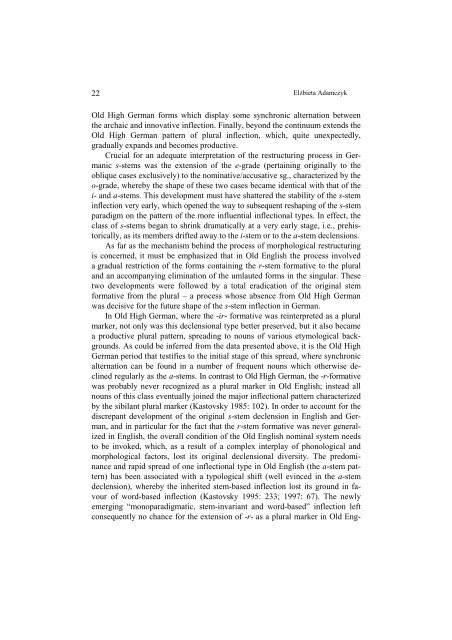s - Wyższa SzkoÅa Filologiczna we WrocÅawiu
s - Wyższa SzkoÅa Filologiczna we WrocÅawiu
s - Wyższa SzkoÅa Filologiczna we WrocÅawiu
Create successful ePaper yourself
Turn your PDF publications into a flip-book with our unique Google optimized e-Paper software.
22<br />
Elżbieta Adamczyk<br />
Old High German forms which display some synchronic alternation bet<strong>we</strong>en<br />
the archaic and innovative inflection. Finally, beyond the continuum extends the<br />
Old High German pattern of plural inflection, which, quite unexpectedly,<br />
gradually expands and becomes productive.<br />
Crucial for an adequate interpretation of the restructuring process in Germanic<br />
s-stems was the extension of the e-grade (pertaining originally to the<br />
oblique cases exclusively) to the nominative/accusative sg., characterized by the<br />
o-grade, whereby the shape of these two cases became identical with that of the<br />
i- and a-stems. This development must have shattered the stability of the s-stem<br />
inflection very early, which opened the way to subsequent reshaping of the s-stem<br />
paradigm on the pattern of the more influential inflectional types. In effect, the<br />
class of s-stems began to shrink dramatically at a very early stage, i.e., prehistorically,<br />
as its members drifted away to the i-stem or to the a-stem declensions.<br />
As far as the mechanism behind the process of morphological restructuring<br />
is concerned, it must be emphasized that in Old English the process involved<br />
a gradual restriction of the forms containing the r-stem formative to the plural<br />
and an accompanying elimination of the umlauted forms in the singular. These<br />
two developments <strong>we</strong>re follo<strong>we</strong>d by a total eradication of the original stem<br />
formative from the plural – a process whose absence from Old High German<br />
was decisive for the future shape of the s-stem inflection in German.<br />
In Old High German, where the -ir- formative was reinterpreted as a plural<br />
marker, not only was this declensional type better preserved, but it also became<br />
a productive plural pattern, spreading to nouns of various etymological backgrounds.<br />
As could be inferred from the data presented above, it is the Old High<br />
German period that testifies to the initial stage of this spread, where synchronic<br />
alternation can be found in a number of frequent nouns which otherwise declined<br />
regularly as the a-stems. In contrast to Old High German, the -r-formative<br />
was probably never recognized as a plural marker in Old English; instead all<br />
nouns of this class eventually joined the major inflectional pattern characterized<br />
by the sibilant plural marker (Kastovsky 1985: 102). In order to account for the<br />
discrepant development of the original s-stem declension in English and German,<br />
and in particular for the fact that the r-stem formative was never generalized<br />
in English, the overall condition of the Old English nominal system needs<br />
to be invoked, which, as a result of a complex interplay of phonological and<br />
morphological factors, lost its original declensional diversity. The predominance<br />
and rapid spread of one inflectional type in Old English (the a-stem pattern)<br />
has been associated with a typological shift (<strong>we</strong>ll evinced in the a-stem<br />
declension), whereby the inherited stem-based inflection lost its ground in favour<br />
of word-based inflection (Kastovsky 1995: 233; 1997: 67). The newly<br />
emerging “monoparadigmatic, stem-invariant and word-based” inflection left<br />
consequently no chance for the extension of -r- as a plural marker in Old Eng-
















